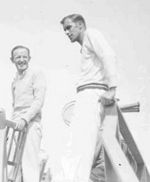Bill Johnston: Difference between revisions
imported>Hayford Peirce (changed 2007 to 2010) |
imported>John Leach (category) |
||
| Line 12: | Line 12: | ||
==See also== | ==See also== | ||
*[[Prominent Tennis Players]] | *[[Prominent Tennis Players]] | ||
==Notes== | |||
{{Reflist}} | |||
==External links== | ==External links== | ||
*[http://www.tennisfame.com/famer.aspx?pgID=867&hof_id=163 Tennis Hall of Fame profile of Bill Johnston] | |||
{{DEFAULTSORT:Johnston, Bill}} | |||
[[Category:Tennis biographies]] | |||
Revision as of 05:20, 11 September 2019

William M. ("Little Bill") Johnston (born November 2, 1894, in San Francisco, California–died May 1, 1946, in San Francisco, California) was a great American tennis player in the first part of the 20th century. He was the co-World No. 1 player in 1919 along with Gerald Patterson.
Until "Big Bill" Tilden began to defeat him regularly in 1920, Johnston had been the best American player for a number of years. He remained competitive with Tilden for the next seven or eight years, but was never again able to beat him in an important match. Together they won seven consecutive Davis Cup trophies, a record that still stands as of 2010.
Johnston was a small, frail-appearing man who suffered ill health from his Navy service in World War I. He was renowned, however, for the power and deadliness of his forehand drive, which he hit shoulder-high with a Western grip, and which was generally considered the best forehand of all time until the advent of Pancho Segura and his two-handed forehand in the late 1940s. Johnston died of tuberculosis in 1946 at the age of 51.
Johnston was inducted into the International Tennis Hall of Fame in Newport, Rhode Island, in 1958.